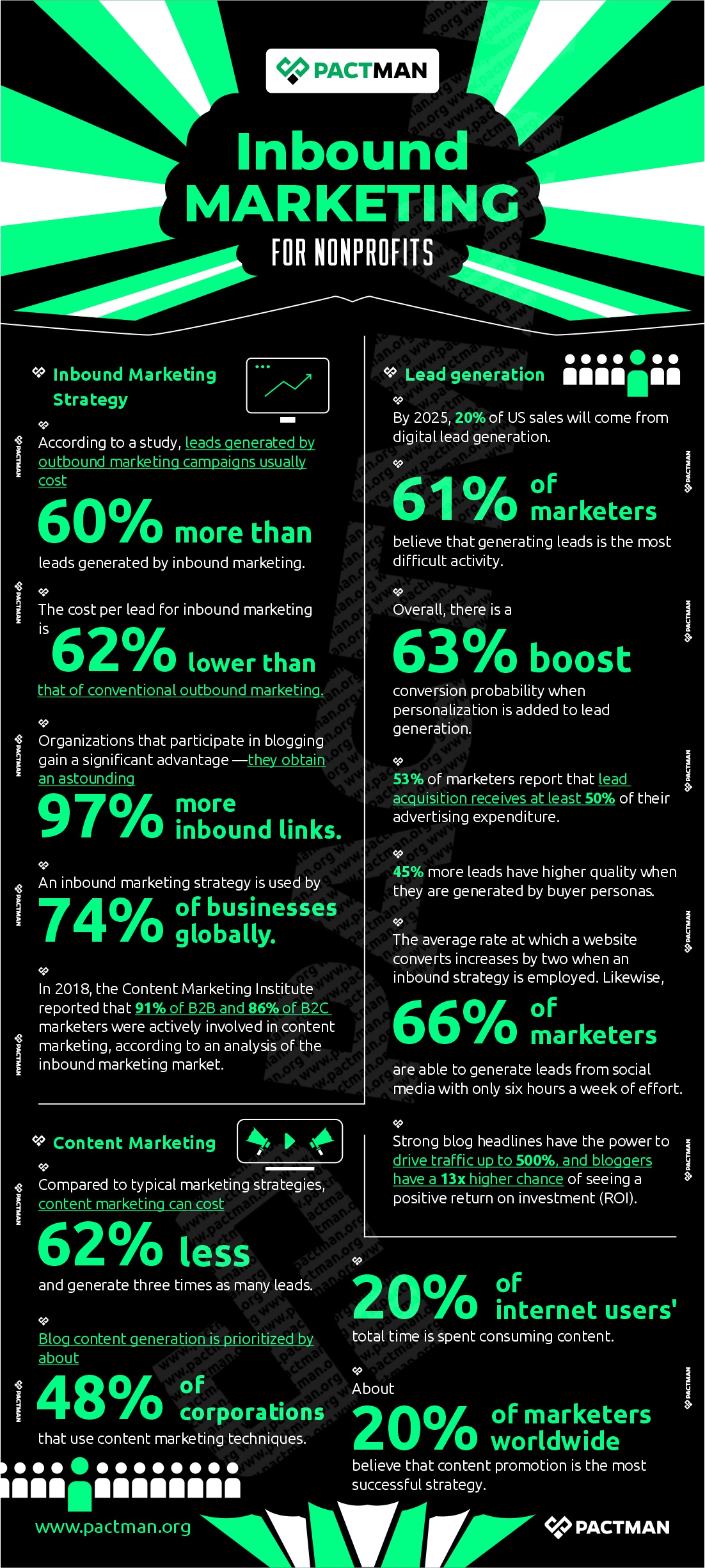I
Introduction
Inbound marketing provides an effective way for nonprofits to increase support for their organization. Proper implementation can help improve website traffic, expand a nonprofit database of potential members, volunteers, and donors, and can be used to accomplish crucial objectives. Most importantly, inbound marketing guarantees a more successful outcome while being less expensive than conventional marketing techniques.

The marketing strategy was created as a technique that leverages online resources like web content, social media, branding, etc. to draw clients and supporters. In contrast, it does not rely on traditional marketing tactics. This is because, more often than not, the majority of people, including your non-profit’s current and potential audiences, are online.
To motivate readers to take action, content developed for inbound marketing should both resonate strongly with a nonprofit’s objective and appeal to a specific target demographic. Also, organizations can rely on the ongoing dedication of individuals who have signified interest in a cause, as this is a considerable investment in and of itself.
II
What is inbound marketing?
Inbound marketing for nonprofits refers to strategies that target donors through content marketing and promotions. As such, inbound marketing can be used to attract audiences more naturally.

Essentially, the goal is to provide content that people genuinely appreciate, rather than just draw in visitors. Even more, this strategy is an effective way to gain the attention of potential donors. This can serve as an alternative to outbound marketing which involves distribution of material to target customers through print ads, commercials, and so on.
With inbound marketing, nonprofits can develop a natural bond with their audience and donors. Using a range of internet channels and focusing on their pre-existing interests, inbound marketing aims to raise awareness and increase traffic more naturally. By and large, this strategy has developed into a more effective marketing tool since the early 2000s and is particularly useful for gaining the attention of your audience.
III
Critical Statistics on Inbound Marketing
In this section, we will consider critical statistics to ascertain the impact of inbound marketing on organizational success.
a. Inbound Marketing Strategy
According to a study, leads generated by outbound marketing campaigns usually cost 60% more than leads generated by inbound marketing. The cost per lead for inbound marketing is 62% lower than that of conventional outbound marketing. Also, organizations that participate in blogging gain a significant advantage—they obtain an astounding 97% more inbound links.
An inbound marketing strategy is used by 74% of businesses globally. In 2018, the Content Marketing Institute reported that 91% of B2B and 86% of B2C marketers were actively involved in content marketing, according to an analysis of the inbound marketing market.

b. Lead generation
By 2025, 20% of US sales will come from digital lead generation. However, 61% of marketers believe that generating leads is the most difficult activity.
Overall, there is a 63% boost in conversion probability when personalization is added to lead generation. 53% of marketers report that lead acquisition receives at least 50% of their advertising expenditure.
Also, 45% more leads have higher quality when generated using buyer personas. For half of marketers, generating leads is the most important aspect of their efforts. The average rate at which a website converts increases by two when an inbound strategy is employed. Likewise, 66% of marketers are able to generate leads from social media with only six hours a week of effort.
Strong blog headlines have the power to drive traffic up to 500%, and bloggers have a 13x higher chance of seeing a positive return on investment (ROI).
c. Content Marketing
Compared to typical marketing strategies, content marketing can cost 62% less and generate three times as many leads. Blog content generation is prioritized by about 48% of corporations that use content marketing techniques. Even more, 20% of internet users’ total time is spent consuming content. About 20% of marketers worldwide believe that content promotion is the most successful strategy.

d. Email marketing
The revenue generated by automated emails surpasses that of non-automated emails by an astounding 320%. Email Monday reports that 55% of businesses presently use marketing automation.
Also, personalized emails have an amazing 188% open rate, while generic emails have a pitiful 12.1% open rate. According to VentureBeat, automated emails have 180% greater conversion rates than batch emails. In addition, 69% of marketers use email marketing to distribute content.
However, despite the effectiveness of email marketing, sending too many emails to subscribers might have unintended consequences. As shown in a report, getting too many emails is the major reason people unsubscribe (59%). Nevertheless, email marketing was highlighted by 53% of marketers as their most successful method for early-stage lead creation.
e. Video Marketing
66% of marketers say that using video marketing increases the number of qualified leads they receive. When compared to text and photos, videos are shared twelve times more frequently. Watching a video helps 95% of customers retain knowledge better than reading a text.
Overall, the bulk of people who watch videos are millennials, defined as those between the ages of 26 and 35. Also, Facebook Live is the live-streaming social media channel of choice for 30% of businesses.
Video is used by 69% of content marketers while 59% of marketers use social media to increase leads and sales. Likewise, 70% of marketers disclosed that raising brand awareness is the main goal of their social media strategy.
IV
Stages of Nonprofit Inbound Marketing
According to the Nonprofit Hub, there are four stages to the nonprofit inbound marketing approach. In the long run, your audience develops and gets closer to your brand as they go through each stage. A closer look at the various phases is provided below:

1. Attract.
Basically, this process justifies itself—you are drawing outsiders to your organization. The key to this phase is knowing who you want as your potential audience. Consider who is the most fit to hear what your nonprofit organization has to say. Thereafter, you can craft messages that pique the interests of your target audience.
Due to the popularity of this phase, you might already be familiar with this aspect of the equation, or you might not, depending on your current outreach. To begin with, nonprofits can leverage social media, blogging, and search engine optimization to build a larger audience.
2. Convert.
Getting your visitors’ contact information is the main goal of this stage, which aims to convert them into leads. The conversion rate of your visitors is critical. Without a contact form, the development of your relationships is impeded. Also, without communication, it is impossible to build a lasting relationship.
There are countless possibilities available in this phase. To begin with, phone numbers and email addresses can be obtained utilizing print and online forms, landing pages, and other similar materials. Never discount the importance of an effective email strategy either. You can provide a little information in exchange for your audience’s important contact information by using emails and calls to action. These are buttons that encourage visitors to undertake a certain activity, like downloading a whitepaper.
3. Close.
Converting your leads into donors is one of the most challenging aspects of nonprofit inbound marketing. If a donor isn’t immediately interested in making a donation, don’t lose hope. It may take some time for these individuals to gain confidence in your organization. Start by providing them with engaging content consistently.
CRM will be a crucial tool during this process. With the aid of CRM software, you may improve audience engagement and streamline your fundraising approach. Also, while you generate useful content and calls to action, it will assist you in growing your contact list.
4. Delight
Following donations, there is a need to retain donors as they develop into advocates for your nonprofit and its goals. Also, it is best to prioritize communication as an effective tool for donor retention.
Utilize surveys to get input on the advantages and disadvantages of your nonprofit. Thereafter, you can monitor your social media accounts to discover the issues your supporters and funders are interested in. Keep in mind that since your content is meant for your audience, they are the finest source of feedback.
Sometimes, it can be difficult to manage the relationship between your organization and its donors. However, the development of such relationships can be greatly aided by the nonprofit inbound marketing method. You’ll be able to accomplish more good in the world if you create content that piques your audience’s attention and makes them receptive to your cause.
V
Benefits of Inbound Marketing
Nonprofits are at the forefront of creating projects that ensure the sustainability and flourishing of communities across the globe. By and large, these organizations are essential to society because they undertake initiatives to support deserving causes.
Nevertheless, without the effective implementation of marketing strategies, NGOs are unlikely to make significant progress. Also, nonprofits can’t afford to invest in traditional marketing strategies because they have a small workforce and little funding. Without a doubt, inbound marketing becomes the best choice for NGOs that are focused on achieving success.

In contrast to for-profit companies, a nonprofit organization’s goal isn’t to maximize profits. This does not, however, imply that organizations cannot benefit from inbound marketing techniques. The primary benefit of inbound marketing is its ability to help a nonprofit gain momentum and expand. Here are some of the many benefits of inbound marketing for nonprofits.
-
Improves brand awareness:
Firstly, inbound marketing places a premium on naturally capturing the target audience’s attention. This isn’t the case for strategies like paid advertising, utilizing sales and marketing teams, and press releases, which focus on buying the audience’s attention.
Using a variety of platforms, including social media, websites, blogs, and email, multi-pronged inbound marketing will raise awareness of your cause and educate potential contributors about how they can provide support.
-
More Affordable
Compared to typical marketing strategies, inbound marketing is often more affordable. By using your website and social media accounts to create and share content, you can cut costs on advertising.
-
Increases Lead generation:
Thirdly, inbound marketing has the potential to increase lead generation for charitable organizations. By providing something of value in return for contact details, you can compile a database of potential donors.
-
Fosters relationships and trust:
Lastly, inbound marketing can help create connections and trust with your target audience. By sending them individualized emails and useful content, you can become recognized as a thought leader in your field.
VI
How Nonprofits Can Leverage Inbound Marketing
In this section, we will consider effective nonprofit strategies for inbound marketing.

a. Convert visitors to subscribers
It’s only half the fight to get people to your website with social media and content. You also want them to take action so you can get in touch with them, build a relationship, and encourage them to donate, volunteer, and support your organization.
To get things going, begin by designing purposeful landing pages with calls-to-action (CTAs). This will encourage users to download exclusive material, follow your organization on social media, or join an online petition to express their support. Also, nonprofit websites must be optimized to boost conversion rates, particularly on landing pages for donations.
b. Build donor personas
Next, you must have a thorough understanding of your various donor personas for your nonprofit inbound marketing to be successful. A donor persona can be defined as an individual donor who embodies the traits, desires, expectations, and qualities of a group of donors in your organization.
To begin with, ask questions such as, what do they need to know about our organization? What makes them interested in participating? Why do they feel so strongly about our goal? Are they interested in donating or volunteering? Also, to ensure that you know who you are marketing to, get to know each audience segment thoroughly.
c. Create high-quality content
Once you are aware of your target audience, you can begin content creation. A solid inbound marketing strategy revolves around content since it drives traffic to your website, maintains reader interest, and motivates participation.
Start by producing interesting, educational, and entertaining videos, blogs, and email newsletters that speak to your many donor personalities. Also, consider the web searches that prospective funders and supporters make and the information they would like to learn about your cause. To inspire others to make a difference, you can choose to share the touching and motivational stories of those who are associated with your organization.
d. Leverage SEO Optimization
Before launching any marketing activity, newly established NGOs with correspondingly new websites should familiarize themselves with SEO (search engine optimization). The ultimate goal of SEO optimization is to make your website more visible in search engine results. In simple terms, SEO facilitates easier site discovery.
Though it’s a continuous process, nonprofits may have an advantage if their website is appropriately optimized from the start. The better your website “looks” to search engines, the more it is likely to rank highly for terms and phrases related to your nonprofit. Hence, it is in your best interest to get some SEO work done on your site before it goes live. This is because it may be time-consuming to go back and rectify problems or update material after a site is already launched.
e. Nurture leads with email marketing
Another means of contacting potential donors is through emails. It’s safe to assume that anyone who wants to get your emails is either interested in your cause or has donated in the past. This is because emails are opt-in, which means that a person must sign up before they can appear on your list and receive messages from you.
For each charity and nonprofit organization, setting up the “right” email marketing program can mean a different procedure. Certain organizations might discover that sending a brief to-the-point message asking for donations once a month suffices and can even prove to be highly productive.
All in all, if organizations wish to use email as a form of inbound marketing, they must be willing to experiment. Aim for what feels right and pay careful attention to the unsubscribe rates. Also, be sure to respond to any emails you receive in response to the ones you sent. Above all, take all reasonable steps to prevent over-sending or spamming your subscribers. If you want to receive donations, you’ll need to hold the interest of your donors and audiences without becoming annoying.
In summary, the steps involved in the inbound marketing process for nonprofits basically entail introducing your organization to donors, catching their interest, and motivating them to donate.
Conclusion
The goal of inbound marketing for nonprofits is to draw potential volunteers, beneficiaries, funders, and supporters to an organization. Essentially, this is achieved by creating content that is tailored to your audience’s needs. Even more, visitors can be motivated to donate, support, and engage with your cause through your digital communications and content. Hence, for NGOs looking to increase their web visibility, inbound marketing is an affordable option. It provides effective ways for NGOs to establish meaningful connections.
Also, since inbound marketing does not promote a particular brand, it is assumed that organizations should take a more gentle approach to attracting donors. Your cause must be acknowledged before you can persuade people to support it. Like for-profit companies, your organization is a brand, and you must be willing to build brand awareness.
If you enjoyed reading this article, please share your comments and suggestions with us at the bottom of this post.



2 Responses